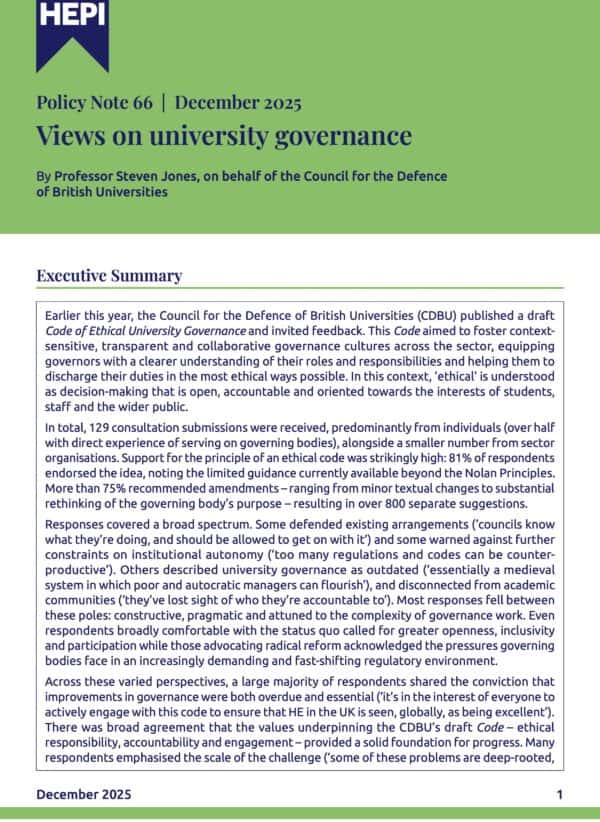What Fields of Study Are Driving International Demand in the UK?
There will be a short-pause in HEPI blogs as we undertake some work on the website. We look forward to delivering blogs to your inbox again later next week.
This HEPI blog was kindly authored by Justin Woods, Director UK of ApplyBoard
As the UK sector anticipates new policy requirements and tighter scrutiny around post-study pathways, aligning programme offerings with student demand has never been more important. Yet, international students bring a wide range of goals and preferences to their study decisions. How can institutions support under-enrolled programmes while continuing to attract high-quality applicants?
Entrant data from the 2023/24 academic year points to some clear shifts, including a higher proportion of international students enrolling in computing/IT and health and medicine.Examining these enrolment patterns by source market and field can help institutions stay aligned with evolving demand.
Computing and Health Made Up a Larger Share of Entrants to the UK in 2023/24
International student demand in the UK evolves in small but meaningful ways. In 2023/24, more students chose to begin their studies in computing/IT and health and medicine, fields that offer clear links to employment and future skill needs.
The overall field of study mix among international students in the UK has remained fairly stable since the pandemic, but subtle shifts are beginning to take shape. The share of entrants in computing/IT was up three percentage points in 2023/24 compared to 2019/20. While modest, this represents a change of several thousand more students choosing this field of study. Health and medicine also remained strong in 2023/24, accounting for more than 11% of new starters.
This trend mirrors developments in the UK labour market. The country’s tech sector now exceeds £1.2 trillion in market value. Meanwhile, NHS staffing shortages remain a pressing concern, with recent estimates pointing to a shortfall of over 10,000 nurses. As students assess where their UK education might lead them, it is likely that domestic labour shortages and growth sectors are shaping the value students perceive in certain programmes. Indeed, when ApplyBoard asked prospective students about their post-study career plans, ‘engineer’ and ‘nurse’ were the two most popular responses, with several tech jobs (such as IT, cybersecurity, and data analysis) appearing in the top 20 as well.
UCAS data for the June 30, 2025 deadline shows that 4,700 international undergraduate students applied for a nursing programme, 19% higher than the 2024 deadline.
Which Student Populations are Driving Demand in Computing/IT and Health and Medicine?
While computing/IT and health and medicine made up 10% and 11% of all international entrants in 2023/24, several student populations pursued these fields at significantly higher rates:
Computing/IT is a top study priority for several key student populations. Nearly one-in-five international students from Myanmar entering the UK in 2023/24 pursued a computing/IT field, more than double the all-market average. Other student populations with notably high engagement in this field of study include those from Qatar, Nepal, Sri Lanka, and India, all of which had 14% or more of their new UK entrants choose computing/IT. All told, these trends show a broad pattern of interest among students across South Asia, the Middle East, and Africa.
Some emerging markets (between 500 and 1,000 entrants in 2023/24) with a high proportion of students entering computing/ITinclude Algeria (23%), Uzbekistan (15%), Morocco (14%), and Bahrain (12%).
Health and medicine shows a comparable trend, with a different mix of student populations driving above-average interest:
Health and medicine draws above-average interest from a globally distributed set of student markets. Students from Ireland, Hong Kong, and Canada were especially likely to enter health and medicine programmes in 2023/24, with one in four entrants from each market choosing this field. Other high-interest markets span the Middle East, Southeast Asia, and Southern Europe, underscoring a wide geographic appeal of health-related fields.
Some emerging markets (between 500 and 1,000 entrants in 2023/24) with a high proportion of students entering health and medicineinclude the Philippines (38%), Zimbabwe (30%), Jordan (19%), and Belgium (19%).
What Fields of Study do the UK’s Largest International Student Populations Pursue?
Field of study preferences don’t just vary by market. They also take on different significance when viewed through the lens of student volume. Looking at the UK’s largest international student populations helps reveal which programmes are driving demand at scale.
Business and law continues to dominate among high-volume source markets, particularly in South Asia. In 2023/24, over half of new students from India and Pakistan entered this field. For China, on the other hand, business and law enrolment has declined steadily. Instead, arts, social sciences, and humanities has become the top choice among students from China, accounting for nearly 38% of entrants in 2023/24.
Engineering and technology, once popular across multiple markets, has seen a notable decline. The field accounted for 12% of international entrants from India in 2019/20 but just 7% in 2023/24. A similar drop occurred among Pakistani students. However, with the UK launching a £54 million recruitment strategy to attract global research talent from the US in June, we expect this field to see somewhat of a rebound over the next couple of years.
Even ashealth and medicine has received increased attention across the UK sector, its performance among the largest student populations remains steady. Indeed, Nigeria and the US remain strong contributors, with 15% of new students entering this field. As institutions prepare for further sectoral reforms and anticipate post-White Paper adjustments, maintaining a steady corridor into healthcare-aligned programmes and post-graduate opportunities could prove especially important in safeguarding both student outcomes and national workforce goals.
Aligning Your Institution With What’s Next
Programme-level shifts in international demand rarely happen all at once, but they matter more than ever in today’s climate of policy change and increasing scrutiny. Institutions that respond early to evolving student priorities will be better positioned to sustain enrolment, diversify their cohorts, and meet labour-aligned goals.







Comments
Ronald Barnett says:
Yet another blog that comes close to making invisible the humanities. Here’s are two sentences:
1) ‘Health and medicine also remained strong in 2023/24, accounting for more than 11% of new starters. No mention in that paragraph that the arts, humanities and social sciences accounted for nearly one quarter of new starters. (Presumably, if one field remains strong at 11%, another field at over double that must be super-strong.)
2) ‘Instead, arts, social sciences, and humanities has become the top choice among students from China, accounting for nearly 38% of entrants in 2023/24.’ This is just thrown-away en passant at the end of a paragraph, with nothing being made of it – yet much could have been made of it, developing that suggestive ‘Instead’.
This is all part of the long trend in the near-silent repudiation – politically, economically, culturally, technologically, digitally – of the humanities.
What is interesting is that the ‘crisis in the humanities’ has been repeatedly noted – though little seriously documented – for 60 years (see Plumb’s book of that title in the mid 1960s) BUT the humanities refuse to die, despite all the underminings that they receive from so many quarters. THAT is an interesting matter deserving of some attention.
Ron Barnett
Reply
kamir bouchareb st says:
thank you for this
Reply
Add comment